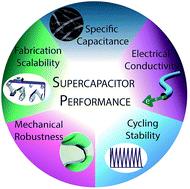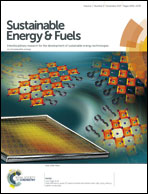Multidimensional performance optimization of conducting polymer-based supercapacitor electrodes
Abstract
Supercapacitors based on conducting polymers promise to bridge the gap between the high power densities of carbon-based double-layer capacitors and the high energy densities of batteries. While much work has focused on improving the specific capacitance of these materials, emerging applications also demand competitive performance with regards to a variety of other criteria, including long-term cycling stability, mechanical robustness, and scalability of fabrication. There is no consolidated summary in the literature, however, of the specific strategies used to target these individual metrics as well as the tradeoffs that exist between them. Herein, we review the most recent progress in engineering high performance conducting polymer-based supercapacitor electrodes, emphasizing the successful techniques for polymer synthesis, nanostructuring, and compositing with carbon or metal oxides which have been used to optimize each of the most important supercapacitor performance metrics.

- This article is part of the themed collection: 2017 Sustainable Energy and Fuels HOT Articles


 Please wait while we load your content...
Please wait while we load your content...